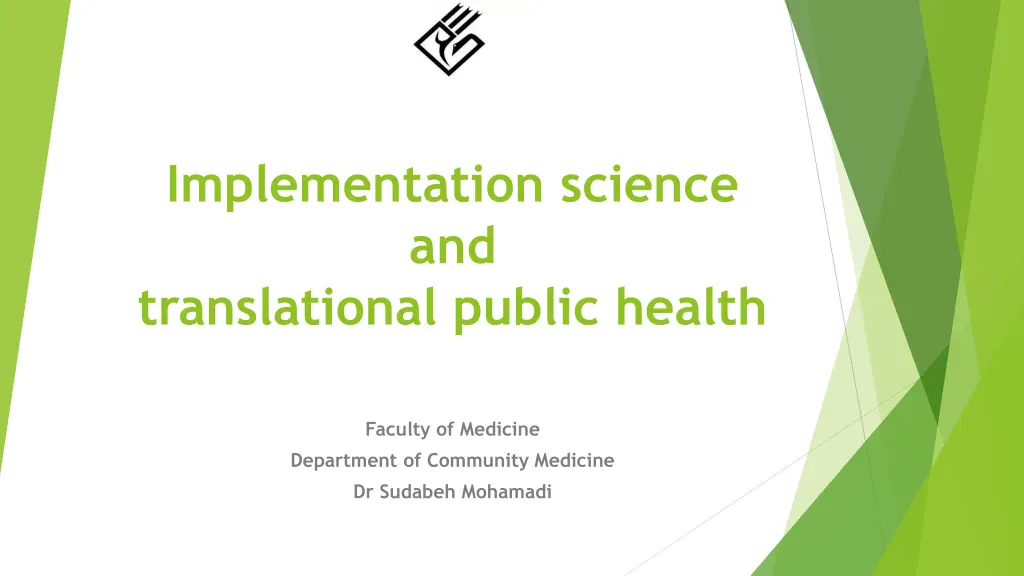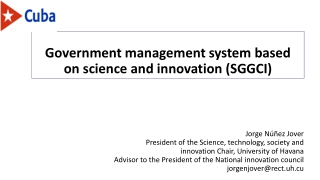
Understanding Implementation Science in Healthcare
Implementation science focuses on strategies to implement evidence-based healthcare interventions in real-life settings to improve quality and effectiveness. It involves studying methods for systematic uptake of research findings to enhance health services and care delivery. The primary aim is to address gaps in healthcare and promote better health outcomes for all populations. Additionally, implementation science aims to inform policymakers about the failures in guidelines and regulations at the frontline of service delivery. By studying various approaches to implementation, the field seeks to optimize the adoption of healthcare technologies and services.
Download Presentation

Please find below an Image/Link to download the presentation.
The content on the website is provided AS IS for your information and personal use only. It may not be sold, licensed, or shared on other websites without obtaining consent from the author. If you encounter any issues during the download, it is possible that the publisher has removed the file from their server.
You are allowed to download the files provided on this website for personal or commercial use, subject to the condition that they are used lawfully. All files are the property of their respective owners.
The content on the website is provided AS IS for your information and personal use only. It may not be sold, licensed, or shared on other websites without obtaining consent from the author.
E N D
Presentation Transcript
Implementation science and translational public health Faculty of Medicine Department of Community Medicine Dr Sudabeh Mohamadi
Introduction Implementation science: the study of strategies undertaken to implement evidence-based technologies, services, diagnostics, (referred to henceforth as healthcare interventions ) in real-life populations and contexts. or therapeutics 3
The subject of study, as described by the National Institutes of Health (NIH), is the implementation method itself or the strategies to adopt evidence-based health interventions and change practice patterns within specific settings . and integrate 4
Implementation research is the scientific study of methods systematic uptake of research findings and other evidence-based practices into routine practice, and, hence, to improve the quality and effectiveness of health services and care . to promote the 5
The primary aim of implementation science is an optimistic one focused on finding the opportunities to improve health and healthcare for all populations where gaps in care currently persist. 6
The goal of implementation science is not only to inform policymakers that create guidelines and new regulations, but also to examine how and why these guidelines, policies, and regulations too often fail at the front lines of service delivery. 7
Preventive health technologies, including ARV medications, can now reduce the risk of perinatally acquired approximately 25 per cent to less than 2 per cent. HIV from 8
The purpose of implementation science is to study the myriad approaches to implementation that are taken with any given healthcare technology or service with the goal of understanding how to close gaps between what we know (evidence-based interventions) and what we actually do at the front lines of healthcare. 9
The audiences for this evidence on implementation policymakers, programme managers, health system designers, practitioners. But, most importantly, the audience is the front-line healthcare workers who seek to more rapidly and reliably deliver the fruits of modern medical science to their patients every day. strategies are and global health 10
While this image locates implementation science in the third translation, we would argue that the study of implementation is also salient to the fourth translation, to population health . 12
Implementation science as a science Parallel investment in the study of implementation in health systems will ensure that all patients can reap the benefits of clinically meaningful new technologies. 13
Origins of implementation science Implementation quantitative traditions as part of its history. science and shares both qualitative analytic 14
W. Edwards Demings system of profound knowledge lies at the heart of the implementation intellectual tradition. This system has four central aspects: understanding of systems understanding of variation theory of knowledge psychology of change 15
The NIH notes that implementation science fundamentally, seeks to understand the behaviour of healthcare professionals and support staff, healthcare organizations, healthcare consumers and family members, and policymakers in context as key variables in the sustainable adoption, implementation and uptake of evidence- based interventions 16
Theory of knowledge = Epistemology Study of how we know things 17
In general, the objectives of monitoring and evaluation implementation are similar: to understand what is working well, what is not working, and why. programs and 18
However, most monitoring and evaluation activities necessarily focus on measuring the services provided rather than on the barriers to implementation. 19
The scientific rigor of implementation research broadens the scope of monitoring and evaluation activities to understand the etiology of gaps between expected results and observed outcomes. 20
despite similarities in objectives and data sources to routine programme monitoring, implementation science remains foremost a rigorous hypothesis-driven investigational activity. 21
The problems of the new discipline The study of implementation is complicated by four important problems. These are the problems of: Scale Context Methods Overconfidence 22
The problem of scale The global public health literature is replete with studies implementation where a particular problem is addressed using a well-resourced, robust implementation strategy that produces a successful pilot circumstances. of small-scale result under study 23
This now evidence-based intervention is then appropriately practitioners and policymakers to be replicated elsewhere. intervention is spread and implemented in multiple different different constraints, and without the carefully controlled study circumstances of the pilot study, the intervention s results are often not replicated. selected by Yet, as the contexts, facing 24
Rapid response systems (RRS): clinical interventions designed to provide an earlier bedside response in the hospital setting to a haemodynamics and to nursing, patient, or family concerns about changes in the patient s condition. patient s changing 25
The problem of context Scaling up requires an accounting of how social, economic, and political contextual details might exert as much influence on uptake of an intervention as the specific details of the healthcare technology itself 26
As the implementation context varies further from the context of the original efficacy study, implementation success further. the chances may of diminish 27
Healthcare organizations are themselves constantly changing which may influence the uptake of an intervention. In order to better inform service delivery, ongoing evaluations of implementation effectiveness will implementers with real-time continuous feedback on how they are changing to affect outcomes. need to provide 28
The problem of method Methods for studying the variety of approaches that may implement a new diagnostic technique or therapeutic across heterogeneous contexts remains scarcely documented. be taken to 29
Only a small fraction of the studies appearing in the implementation studies from resource- limited contexts. journal describe 30
The problem of overconfidence and unintended variation The principles of authority, autonomy, and independent responsibility for services to the individual patient are deeply embedded in the psychology of the practitioner and in the psychology of many patients who seek the expert counsel of their doctors. 31
Physician decisions are influenced by: their peers their patients their professional societies 32
Implementation science study design The core elements of study design: understanding the subject of study identifying the primary research question planning measures selecting the format for the study including considerations of control groups and strategies for eliminating bias 33
These are not unique to implementation science studies, but in the context of studying implementation they do have unique features. 34
Understanding the subject of implementation science: the approach to implementation The units of study may be individual patients, but more often the units of study are health facilities, hospital wards, health districts, or geographic populations. 35
As a clinical researcher studies new interventions and tries to characterize and control for the individual patients, the implementation scientist studies new approaches to provide an existing technology and tries to characterize and control for variability between units of study (health facilities, hospital wards, health districts). variability between 36
A non-exhaustive list of examples of implementation approaches might include: 1. Executive mandate the quintessential top-down approach where a chief executive requires, or mandates, a group of individuals, an organization, or a geopolitical entity to implement a healthcare intervention. 37
2. Guidelines (clinical practice guidelines) practice recommendations developed by a discipline s governing academic society or group of expert practitioners. Guidelines are often amalgamated from the clinical trials results and are thus referred to as being evidence based . 38
3. Clinical protocols or pathwaysbased on clinical practice guidelines and standards, but locally adapted: step-by-step translation of the guidelines Protocols represented as flow charts, algorithms, or other similar diagrams. or pathways often are 39
4. Trainingan important implementation approach that focuses primarily in providing knowledge to clinicians, healthcare workers, patients, and families. 40
5. Task shiftingoften the approach to improvement may involve changing the types of personnel or locale where a health technology is provided. 41
6. Checklistsa tool which provides a simplified visual reminder of aspects of a clinical protocol or pathway. Checklists consistency implementation. are designed and to improve reliability of 42
7. Campaignspublic health campaigns have been used to spread evidence-based clinical practices to a large region. 43
The 3 by 5 Initiative was an initiative of the World Health Organization (WHO) to provide antiretroviral treatment to patients with HIV/AIDS in low- and middle-income countries. The program December 2003 to December 2005, and the name "3 by 5" refers to the goal of treating 3 million people by 2005. lasted from 44
8. governments can legislate the right to basic primary healthcare services for their citizens as a primary method for implementation. Laws and regulation National 45
9. incentives implementation consistency and reliability. Pay-for-performance and and use improve of penalties to Payment can come in many forms including financial and public recognition. 46
10. Process improvementderived from management sciences, healthcare systems as complex processes which can be systematically improved using a combination of tools to diagnose system failures (e.g. process maps), an incremental problem-solving approach (e.g. Plan Do Study Act cycles), measurement and evaluation techniques. views dynamic and time-series 47
Box 6.9.1 The quality improvement approach The quality improvement (QI) approach is an implementation grounded in operations research and management science, two well-established fields that have combined the disciplines of statistics, psychology, systems engineering, and iterative learning, to have major impacts on systems performance across countries and industries. method that is 48
QI seeks to design systems for maximum effectiveness, efficiency, and adaptability and to actively disseminate the best models for health service delivery at a rapid rate. 49






















